Evaluation of a Simplified Direct SSI Method in the Dynamic Seismic Behavior of Traditional RC Minarets
Abstract
:1. Introduction
2. Materials and Methods
2.1. Finite Element Models of the Minarets
2.2. Selected Ground Motions
2.3. Modeling and the Properties of Underlying Soil
3. Dynamic Seismic Assessment of Model Minarets Incorporating SSI
3.1. First-Mode Periods and Modal Participating Mass Ratios
3.2. Seismic Analysis
3.2.1. The Effect of SSI
3.2.2. The Effect of Soil Type
3.2.3. Stress Distributions
3.3. Performance Evaluation
3.4. Precautions Suggested
4. Conclusions
- Even in the S1 type of soil compared to the fixed model, the top displacements increased rapidly, which shows the importance of considering SSI in the dynamic response of RC minarets. As the soil gets softer from the fixed S3 type of soil, the top displacements ascended and the related IDRs also increased.
- The structural behavior, i.e., top displacements of the representative minarets, are homogeneous when the soil type is stiff (S1), i.e., the maximum top displacements occurred approximately at the same time interval. Therefore, it is possible to predict the structural behavior of the representative minarets when the soil is stiffer. However, when the soil gets softer to the S2 or S3 type of soil, it becomes impossible to guess the structural behavior of the representative minarets i.e., the maximum top displacements did not occur at the same time interval when the time histories were explored.
- For all models considered, the top displacement demands obtained from İzmit earthquake are higher compared to the top displacement demands obtained from the Van earthquake. This clearly shows the effect of acceleration created from the İzmit earthquake.
- The maximum value of the IDR is obtained for Model 2 under the İzmit earthquake for the S3 type of soil. Additionally, the value of IDRs increases for all models and earthquakes investigated, ranging from the fixed type of soil to the S3 type of soil, indicating the need of taking SSI into account when analyzing the seismic behavior of RC minarets. The damage limit value of 0.005 is satisfied by the IDRs for all models under the Van earthquake that have a fixed type of soil. Furthermore, the IDR values for the models taking into account SSI (apart from Model 2 with the S1 soil type under the Van earthquake) do not fulfil the damage limit value of 0.005, which indicates the probability of irreversible damage to the structure. This demonstrates how important it is that the SSI be considered for these kinds of tall, thin and special structures.
- For the representative minarets considered, the maximum and minimum stress concentrations, Smax and Smin, are at the end of the transition segment. Stated differently, practically all investigations on the seismic behavior of minarets indicate that the main areas of stress concentration are between the transition segment and the main body of the minaret, even with linear models. By adding a buttressed element to the cross-section or wrapping FRP around the cylindrical body of the RC minaret, it is possible to significantly reduce the lateral displacement demands of the structural system and hence the values of Smax and Smin stresses that cause brittle failure.
- As cited before, the jet grouting method is an effective way to improve the mechanical properties of the soil. In this way, the top displacements and stress distribution over RC minarets can be reduced to a tolerable limit.
Funding
Data Availability Statement
Conflicts of Interest
References
- Günaydın, M.; Tonyalı, Z. Dynamic response of a reinforced concrete minaret. J. Struct. Eng. Appl. Mech. 2018, 1, 62–72. [Google Scholar] [CrossRef]
- Erdik, M.; Biro, Y.A.; Onur, T.; Sesetyan, K.; Birgoren, G. Assessment of earthquake hazard in Turkey and neighboring regions. Ann. Geophys. 1999, 42, 1125–1138. [Google Scholar] [CrossRef]
- Gülkan, P.; Kalkan, E. Attenuation modeling of recent earthquakes in Turkey. J. Seismol. 2002, 6, 397–409. [Google Scholar] [CrossRef]
- Tan, O.; Tapirdamaz, M.C.; Yörük, A. The earthquake catalogues for Turkey. Turk. J. Earth Sci. 2008, 17, 405–418. [Google Scholar]
- Ersoy, Ş.; Gürüm, T. 23 October 2011 Geological and Geomorphological Preliminary Evaluation Report on Van Earthquake (Mw 7.2); Department of Earthquake Engineering, Boğaziçi University: İstanbul, Turkey, 2011. [Google Scholar]
- Şanlı, A.; Utkucu, M.; Yalçın, H. A finite fault model of the March 13, 1992 Erzincan (Mw = 6.8) from the inversion of teleseismic P and SH waveforms. In Proceedings of the 4th International Conference on Earthquake Engineering and Seismology, Eskişehir, Turkey, 10–13 October 2017. [Google Scholar]
- AFAD. Available online: https://deprem.afad.gov.tr/assets/pdf/deprem-bilgi-destek-sistemi.pdf (accessed on 10 May 2023).
- Sezen, H.; Fırat, G.Y.; Sözen, M.A. Investigation of the performance of monumental structures during the 1999 Kocaeli and Düzce earthquakes. In Proceedings of the 5th National Conference on Earthquake Engineering, İstanbul, Turkey, 26–30 May 2003. [Google Scholar]
- Doğangün, A.; Acar, R.; Livaoğlu, R.; Tuluk, Ö.İ. Performance of masonry minarets against earthquakes and winds in Turkey. In Proceedings of the 1st International Conference on Restoration of Heritage Masonry Structures, Cairo, Egypt, 24–27 April 2006. [Google Scholar]
- Doğangün, A.; Sezen, H.; Tuluk, Ö.İ.; Livaoğlu, R.; Acar, R. Traditional Turkish masonry monumental structures and their earthquake response. Int. J. Archit. Herit. 2007, 1, 251–271. [Google Scholar] [CrossRef]
- Acar, R.; Livaoglu, R.; Dogangun, A.; Sezen, H. The effects of subsoils on the seismic response of reinforced concrete cylindrical minarets. In Proceedings of the 5th International Conference on Seismology and Earthquake Engineering, Tehran, Iran, 13–16 May 2007. [Google Scholar]
- Doğangün, A.; Acar, R.; Sezen, H.; Livaoglu, R. Investigation of dynamic response of masonry minaret structures. Bull. Earthq. Eng. 2008, 6, 505–517. [Google Scholar] [CrossRef]
- Doğangün, A.; Sezen, H. Seismic vulnerability and preservation of historical masonry monumental structures. Earthq. Struct. 2012, 3, 83–95. [Google Scholar] [CrossRef]
- Sezen, H.; Dogangun, A. Seismic performance of historical and monumental structures. In Earthquake Engineering; InTech: London, UK, 2012. [Google Scholar]
- Oliveira, C.S.; Çaktı, E.; Stengel, D.; Branco, M. Minaret behavior under earthquake loading: The case of historical Istanbul. Earthq. Eng. Struct. Dyn. 2012, 41, 19–39. [Google Scholar] [CrossRef]
- Türk, A.M. Seismic response analysis of masonry minaret and possible strengthening by fiber reinforced cementitious matrix (FRCM) materials. Adv. Mater. Sci. Eng. 2013, 2013, 952497. [Google Scholar] [CrossRef]
- URL-1. Available online: https://www.trthaber.com/haber/turkiye/adiyamanda-minare-binayi-ikiye-boldu-749846.html (accessed on 10 May 2023).
- Sezen, H.; Acar, R.; Dogangun, A.; Livaoglu, R. Dynamic analysis and seismic performance of reinforced concrete minarets. Eng. Struct. 2008, 30, 2253–2264. [Google Scholar] [CrossRef]
- Pak, R.Y.S.; Guzina, B.B. Seismic soil-structure interaction analysis by direct boundary element methods. Int. J. Solids Struct. 1999, 36, 4743–4766. [Google Scholar] [CrossRef]
- Yazdchi, M.; Khalili, N.; Valliappan, S. Dynamic soil–structure interaction analysis via coupled finite-element–boundary-element method. Soil Dyn. Earthq. Eng. 1999, 18, 499–517. [Google Scholar] [CrossRef]
- Mylonakis, G.; Gazetas, G. Seismic soil-structure interaction: Beneficial or detrimental? J. Earthq. Eng. 2000, 4, 277–301. [Google Scholar] [CrossRef]
- Tabatabaiefar, H.R.; Massumi, A. A simplified method to determine seismic responses of reinforced concrete moment resisting building frames under influence of soil–structure interaction. Soil Dyn. Earthq. Eng. 2010, 30, 1259–1267. [Google Scholar] [CrossRef]
- Lai, C.G.; Menon, A.; Macchi, G. Seismic vulnerability of the minaret of Jam in Afghanistan. In Proceedings of the XI National Congress of Seismic Engineering, Genoa, Italy, 25–29 January 2004. [Google Scholar]
- Doğangün, A.; Livaoğlu, R.; Acar, R. A study on seismic behavior of minarets considering soil-structure interaction. In Proceedings of the International Earthquake Symposium, Kocaeli, Turkey, 22–26 October 2007. [Google Scholar]
- Doğangün, A.; Tuluk, Ö.İ.; Livaoğlu, R.; Acar, R. Traditional Turkish minarets on the basis of architectural and engineering concepts. In Proceedings of the 1st International Conference on Restoration of Heritage Masonry Structures, Cairo, Egypt, 24–27 April 2006. [Google Scholar]
- Örmecioglu, H.T.; Aslı, E.R.; Beeson, S.T.; Özmen, C. Structural analysis and seismic behavior of Yivli Minaret. Süleyman Demirel Univ. Int. J. Tech. Sci. 2011, 3, 52–61. [Google Scholar]
- Cosgun, C.; Türk, A.M. Seismic behaviour and retrofit of historic masonry minaret. Građevinar 2011, 64, 39–45. [Google Scholar] [CrossRef]
- Mortezaei, A.; Kheyroddin, A.; Ronagh, H.R. Finite element analysis and seismic rehabilitation of a 1000-year-old heritage listed tall masonry mosque. Struct. Des. Tall Spec. 2012, 21, 334–353. [Google Scholar] [CrossRef]
- Pekgökgöz, R.K.; Gürel, M.A.; Mammadov, Z.; Çili, F. Dynamic analysis of vertically post-tensioned masonry minarets. J. Earthq. Eng. 2013, 17, 560–589. [Google Scholar] [CrossRef]
- Türkeli, E. Determination and comparison of wind and earthquake responses of reinforced concrete minarets. Arab. J. Sci. Eng. 2014, 39, 3665–3680. [Google Scholar] [CrossRef]
- Clemente, P.; Saitta, F.; Buffarini, G.; Platania, L. Stability and seismic analyses of leaning towers: The case of the minaret in Jam. Struct. Des. Tall Spec. 2015, 24, 40–58. [Google Scholar] [CrossRef]
- Türkeli, E.; Livaoğlu, R.; Doğangün, A. Dynamic response of traditional and buttressed reinforced concrete minarets. Eng. Fail. Anal. 2015, 49, 31–48. [Google Scholar] [CrossRef]
- Ural, A.; Firat, F.K. Evaluation of masonry minarets collapsed by a strong wind under uncertainty. Nat. Hazards 2015, 76, 999–1018. [Google Scholar] [CrossRef]
- Başaran, H.; Demir, A.; Ercan, E.; Nohutcu, H.; Hökelekli, E.; Kozanoğlu, C. Investigation of seismic safety of a masonry minaret using its dynamic characteristics. Earthq. Struct. 2016, 10, 523–538. [Google Scholar] [CrossRef]
- Erdoğan, Y.S.; Kocatürk, T.; Demir, C. Investigation of the seismic behavior of a historical masonry minaret considering the interaction with surrounding structures. J. Earthq. Eng. 2017, 23, 112–140. [Google Scholar] [CrossRef]
- Hacıefendioğlu, K.; Alpaslan, E.; Demir, G.; Dinç, B.; Birinci, F. Experimental modal investigation of scaled minaret embedded in different soil types. Građevinar 2018, 70, 201–212. [Google Scholar]
- Altun, N. Project of the Concrete Minarets Considering the Soil-Structure Interaction in the Light of 2007 and 2018 Earthquake Regulations. Master’s Thesis, Ondokuz Mayıs University, Samsun, Turkey, 2019. [Google Scholar]
- Türkeli, E. Comparative dynamic seismic analyses of RC minarets strengthened with FRP and buttresses. J. Nat. Hazard Environ. 2020, 6, 119–136. [Google Scholar] [CrossRef]
- Wilson, E.L. SAP 2000: Integrated Finite Element Analysis and Design of Structures; Computers & Structures: Berkeley, CA, USA, 2000. [Google Scholar]
- Livaoğlu, R.; Doğangün, A. Effect of foundation embedment on seismic behavior of elevated tanks considering fluid–structure-soil interaction. Soil Dyn. Earthq. Eng. 2007, 27, 855–863. [Google Scholar] [CrossRef]
- Lysmer, J.; Kuhlemeyer, R.L. Finite dynamic model for infinite media. J. Eng. Mech. Div. 1969, 95, 859–878. [Google Scholar] [CrossRef]
- Livaoglu, R.; Cakir, T.; Dogangun, A.; Aytekin, M. Effects of backfill on seismic behavior of rectangular tanks. Ocean Eng. 2011, 38, 1161–1173. [Google Scholar] [CrossRef]
- Bao, H.; Hatzor, Y.H.; Huang, X. A new viscous boundary condition in the two-dimensional discontinuous deformation analysis method for wave propagation problems. Rock. Mech. Rock. Eng. 2012, 45, 919–928. [Google Scholar] [CrossRef]
- Burman, A.; Nayak, P.; Agrawal, P.; Maity, D. Coupled gravity dam–foundation analysis using a simplified direct method of soil–structure interaction. Soil Dyn. Earthq. Eng. 2012, 34, 62–68. [Google Scholar] [CrossRef]
- URL-2. Available online: https://tadas.afad.gov.tr/login (accessed on 16 March 2023).
- URL-3. Available online: https://dogruhaber.com.tr/haber/909777-depremde-yikilan-minare-3-katli-apartmanin-uzerine-tek-parca-seklinde-devrildi/ (accessed on 23 April 2024).
- EN 1998-6 (2005); Eurocode 8: Design of Structures for Earthquake Resistance-Part 6: Towers, Masts and Chimneys. Comite Europeen De Normalisation: Brussels, Belgium, 2005.
- Shabani, A.; Feyzabadi, M.; Kioumarsi, M. Model updating of a masonry tower based on operational modal analysis: The role of soil-structure interaction. Case Stud. Constr. Mater. 2022, 16, e00957. [Google Scholar] [CrossRef]
- Altunişik, A.C. Dynamic response of masonry minarets strengthened with Fiber Reinforced Polymer (FRP) composites. Nat. Hazard Earth Sys. 2011, 11, 2011–2019. [Google Scholar] [CrossRef]
- Karaca, Z.; Türkeli, E.; Günaydın, M.; Adanur, S. Dynamic responses of industrial reinforced concrete chimneys strengthened with fiber-reinforced polymers. Struct. Des. Tall Spec. Build. 2015, 24, 228–241. [Google Scholar] [CrossRef]
- Karahan, G.N.; Sivrikaya, O. Designing singular jet grouting column for sandy soils. Environ. Earth Sci. 2018, 77, 448. [Google Scholar] [CrossRef]
- Güllü, H. A novel approach to prediction of rheological characteristics of jet grout cement mixtures via genetic expression programming. Neural Comput. Appl 2017, 28, 407–420. [Google Scholar] [CrossRef]
- Doğangün, A.; Acar, R.; Livaoglu, R.; Sezen, H. Comparison of structural response of traditional and strengthened reinforced concrete minarets. In Proceedings of the 5th International Conference on Seismology and Earthquake Engineering, Tehran, Iran, 13–16 May 2007. [Google Scholar]
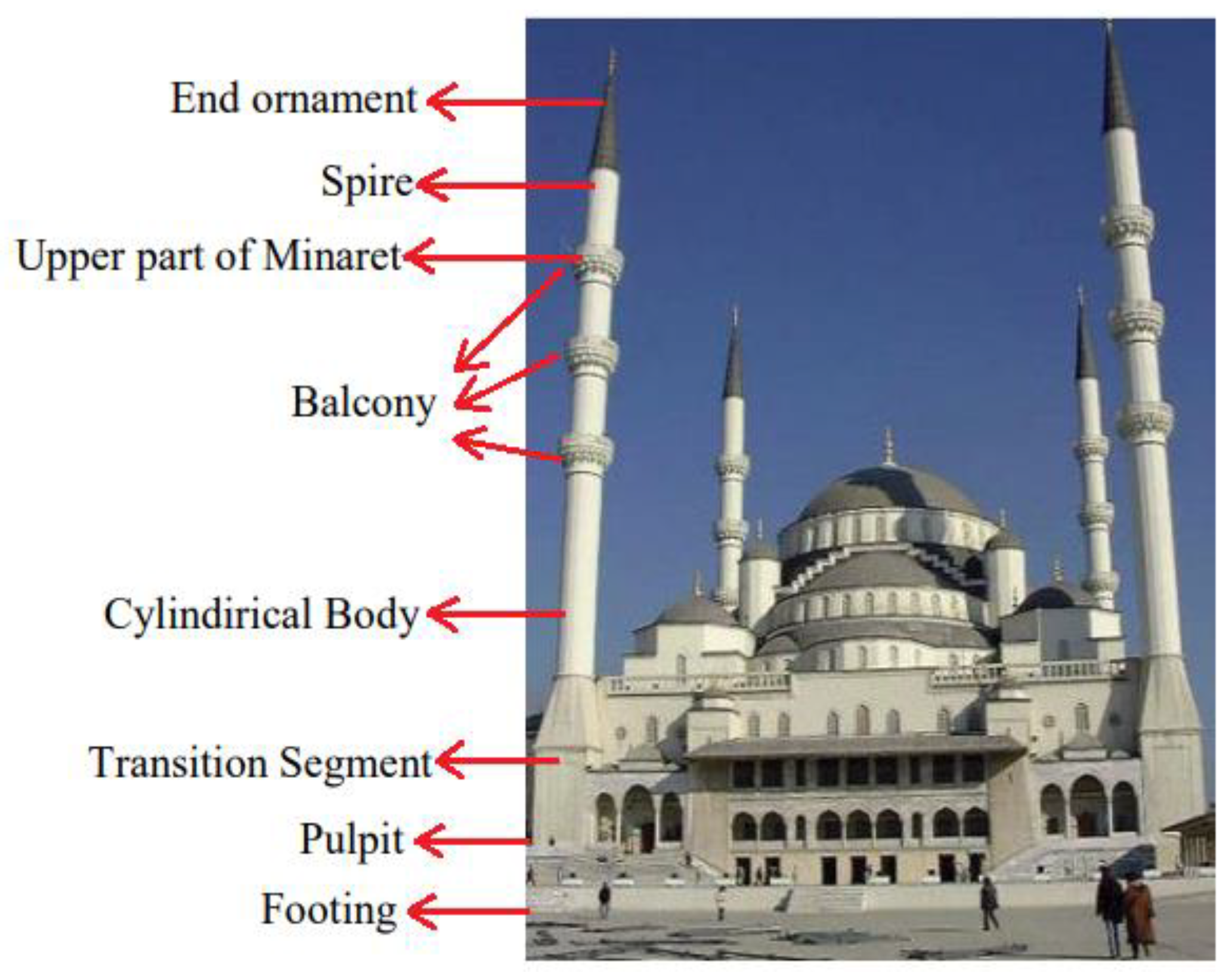
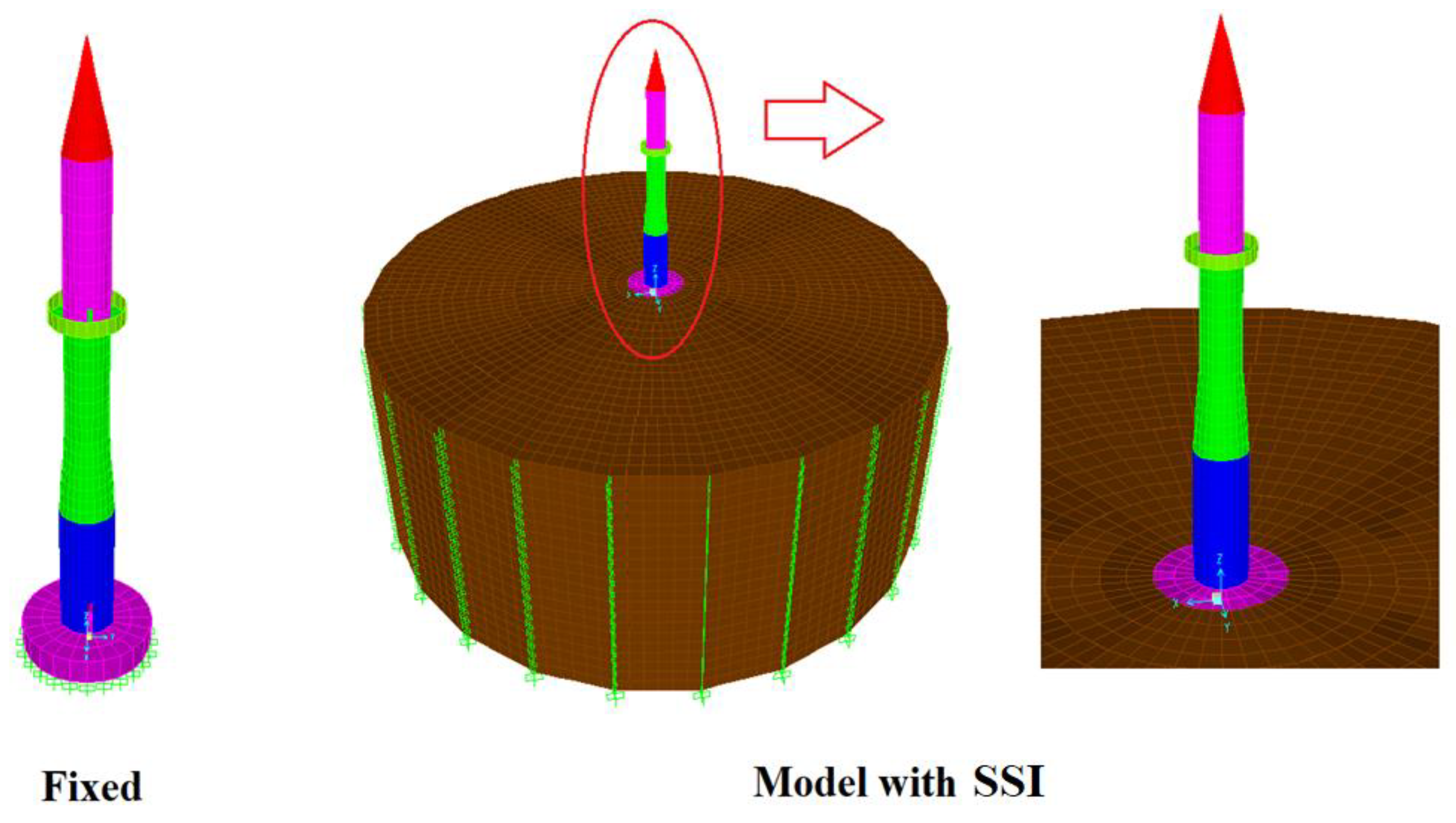
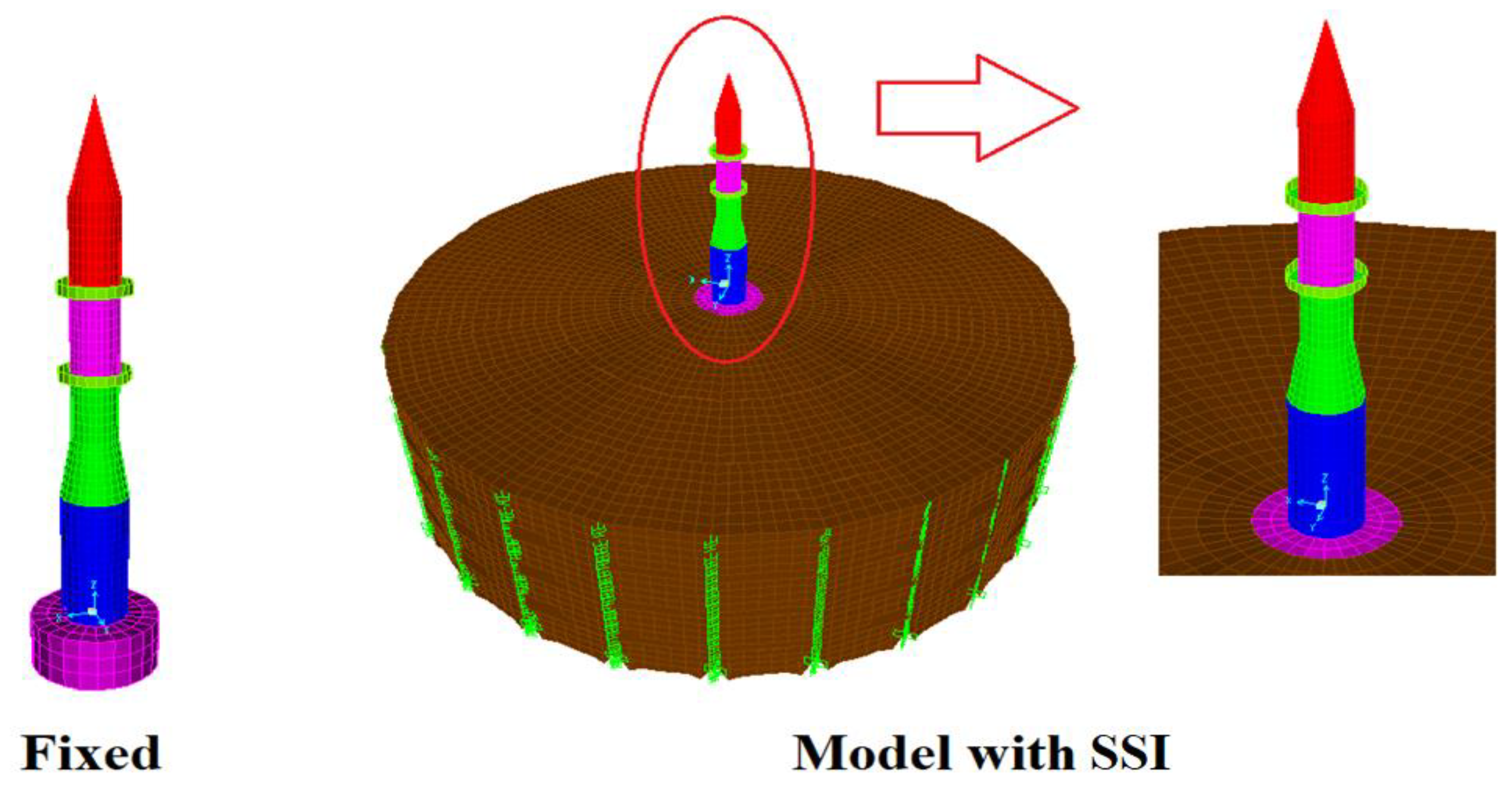
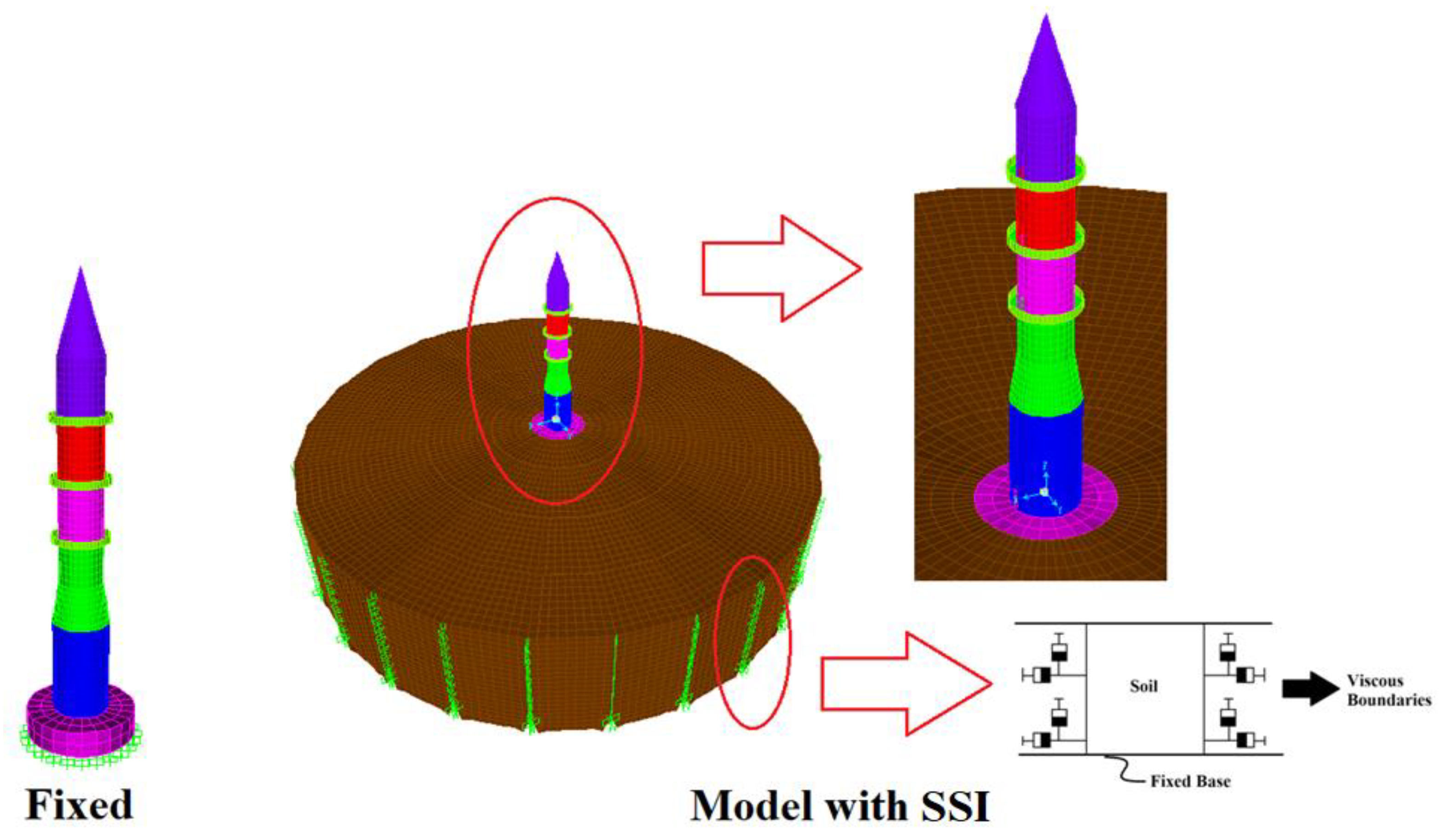
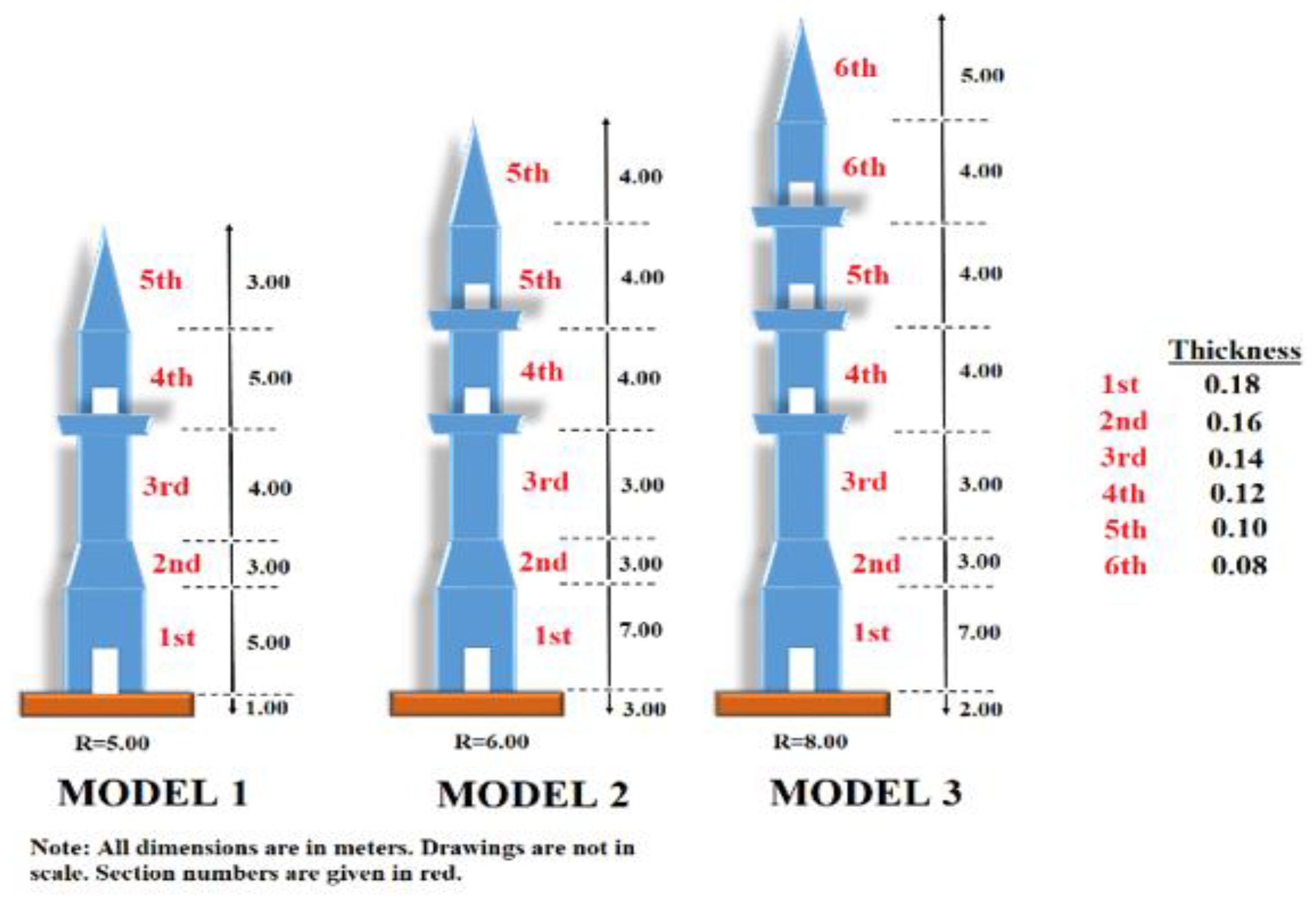

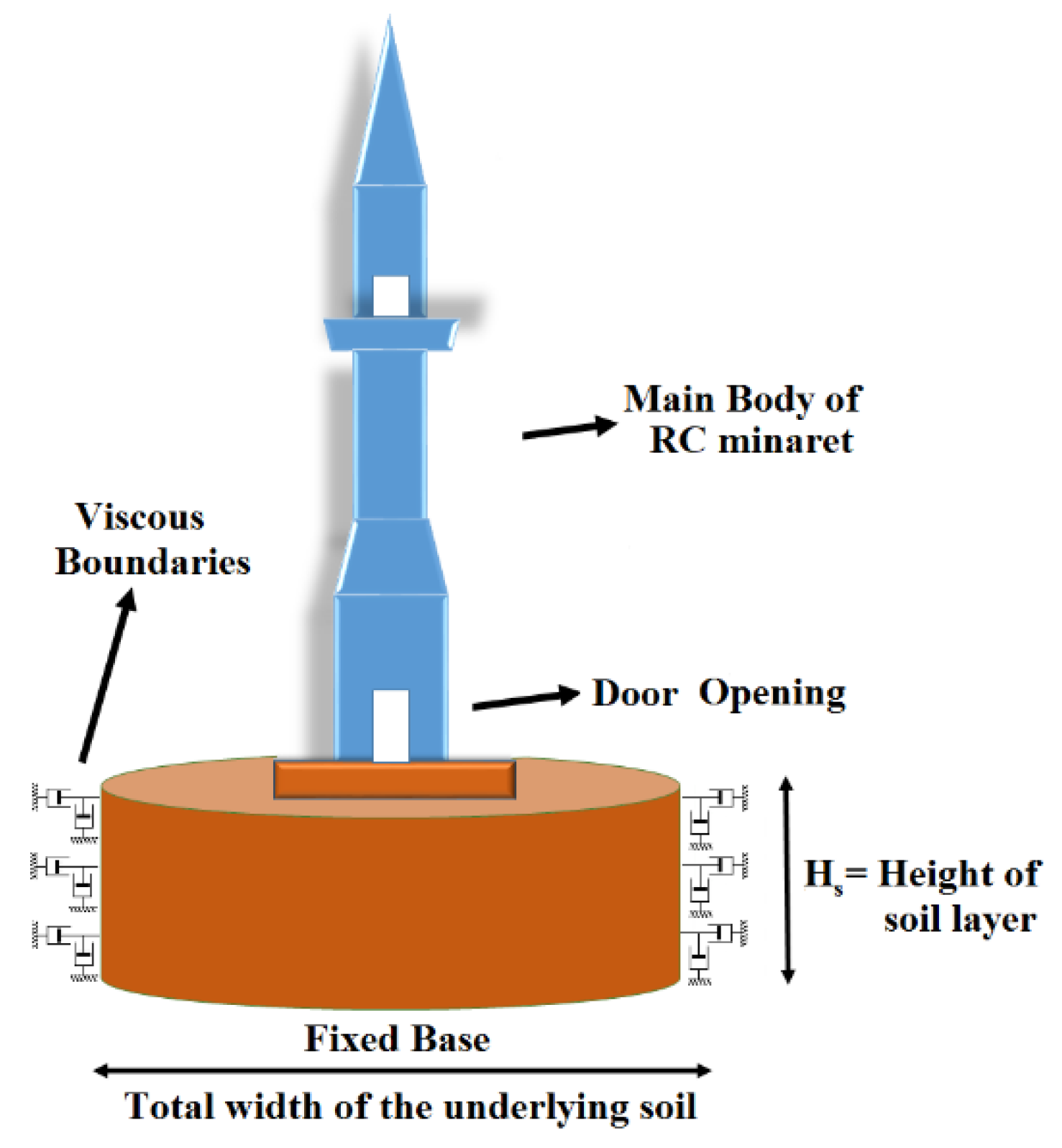

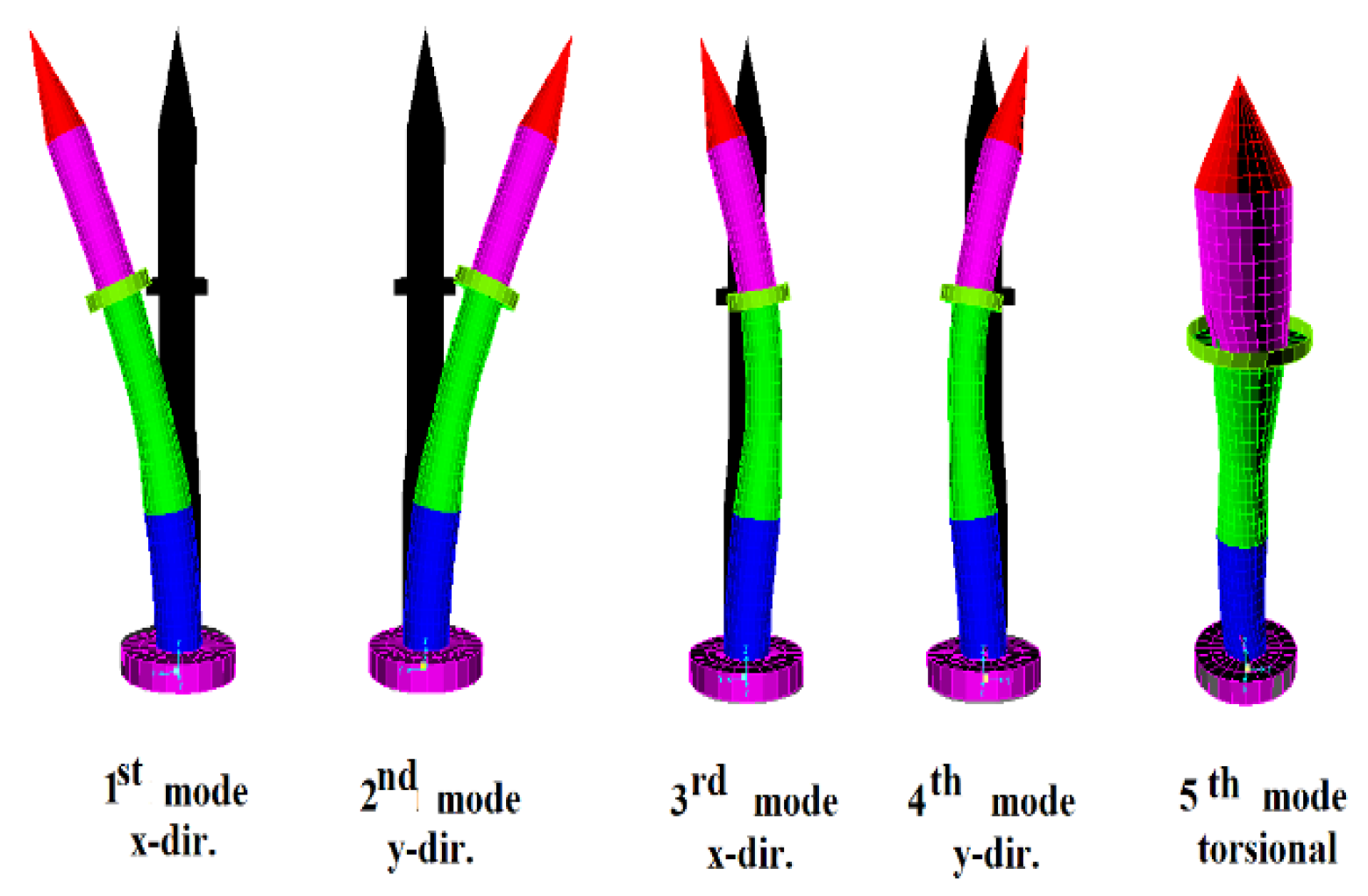
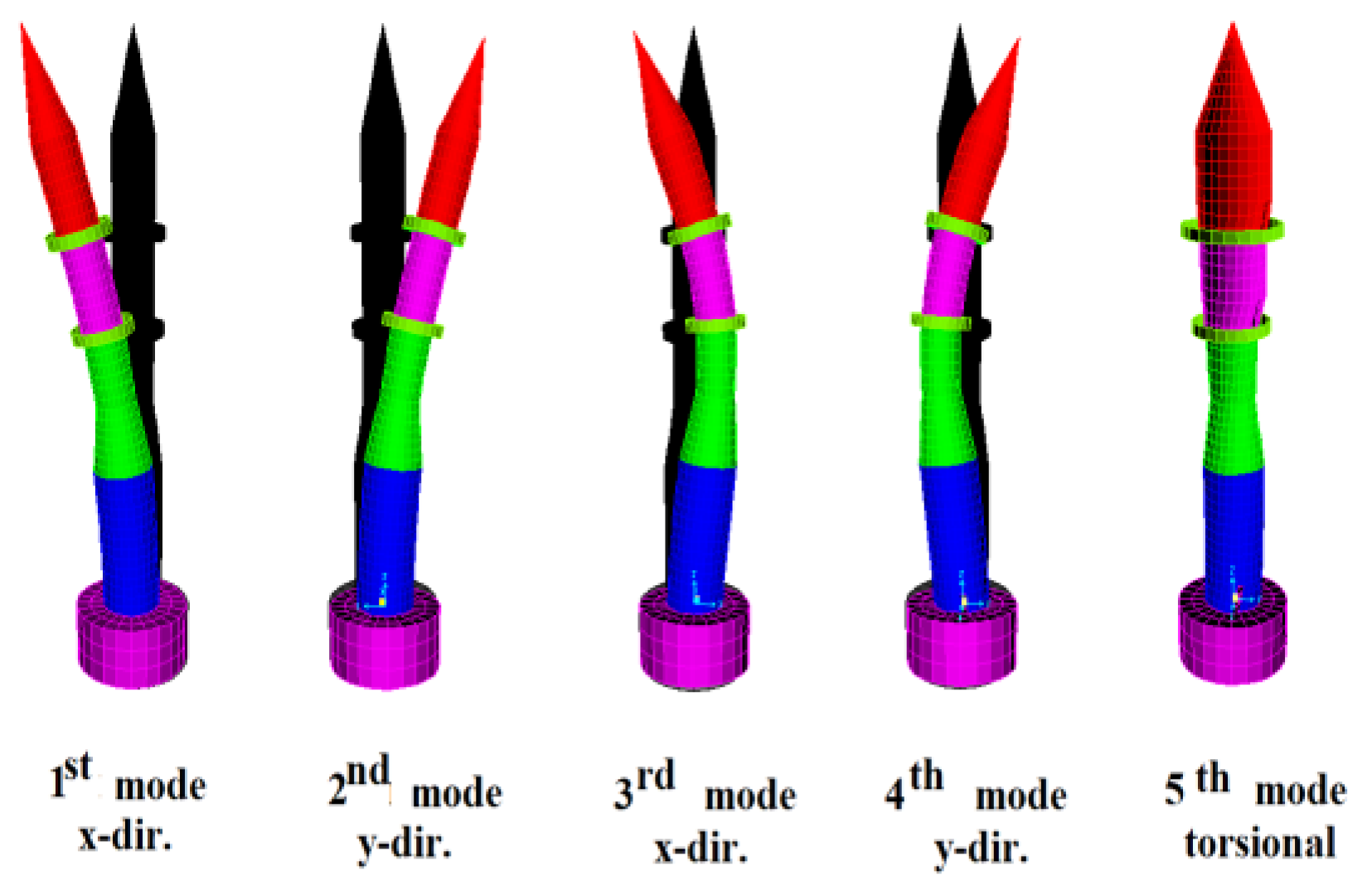













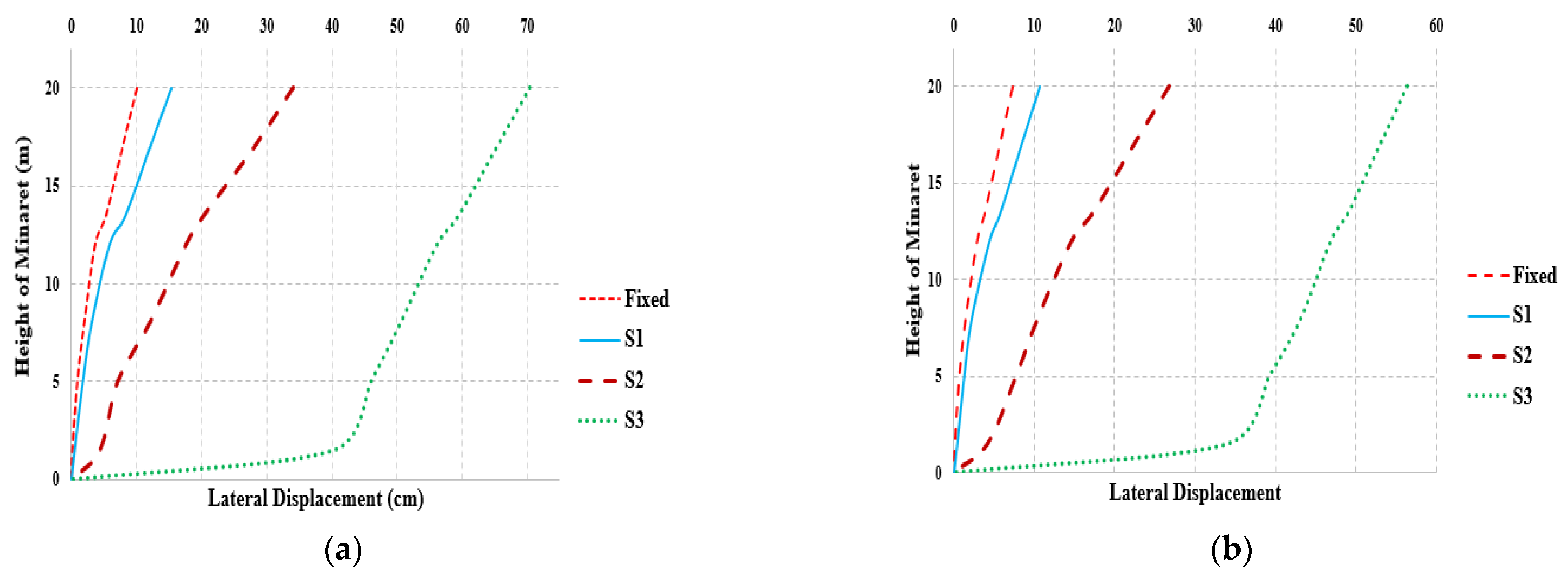
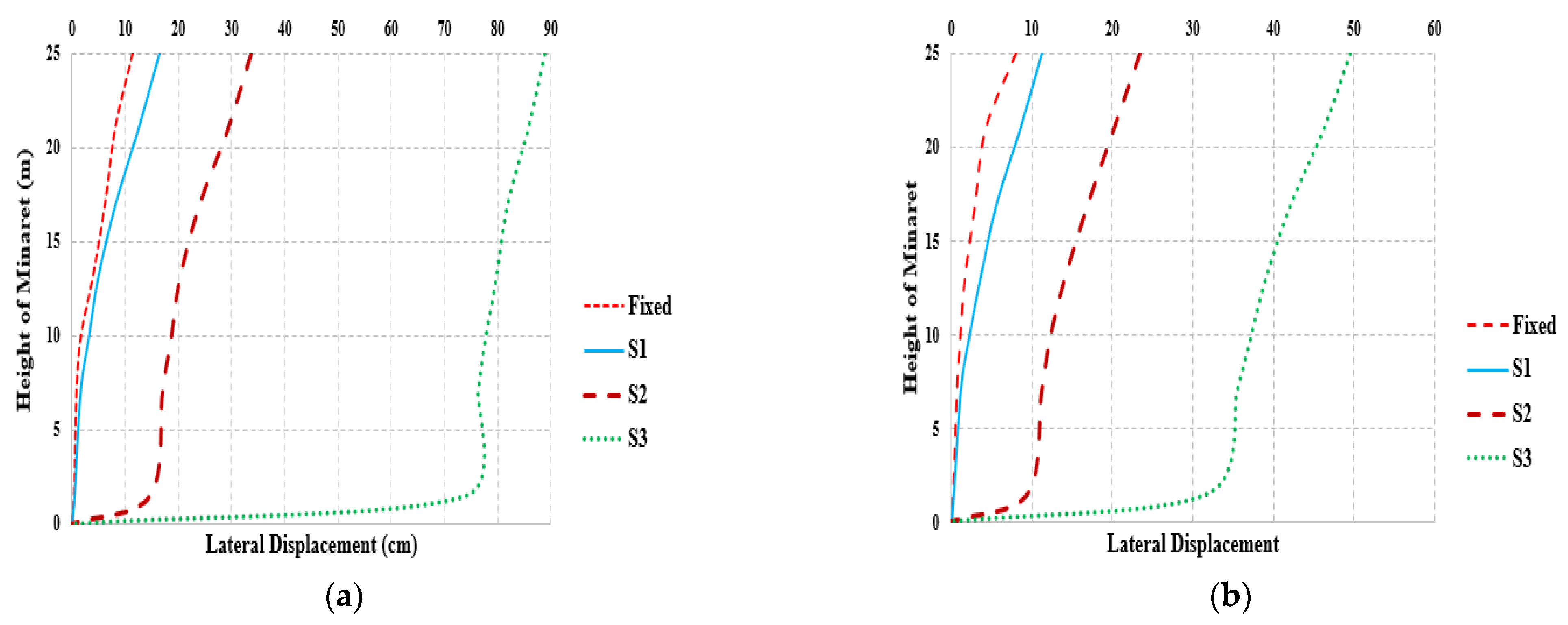

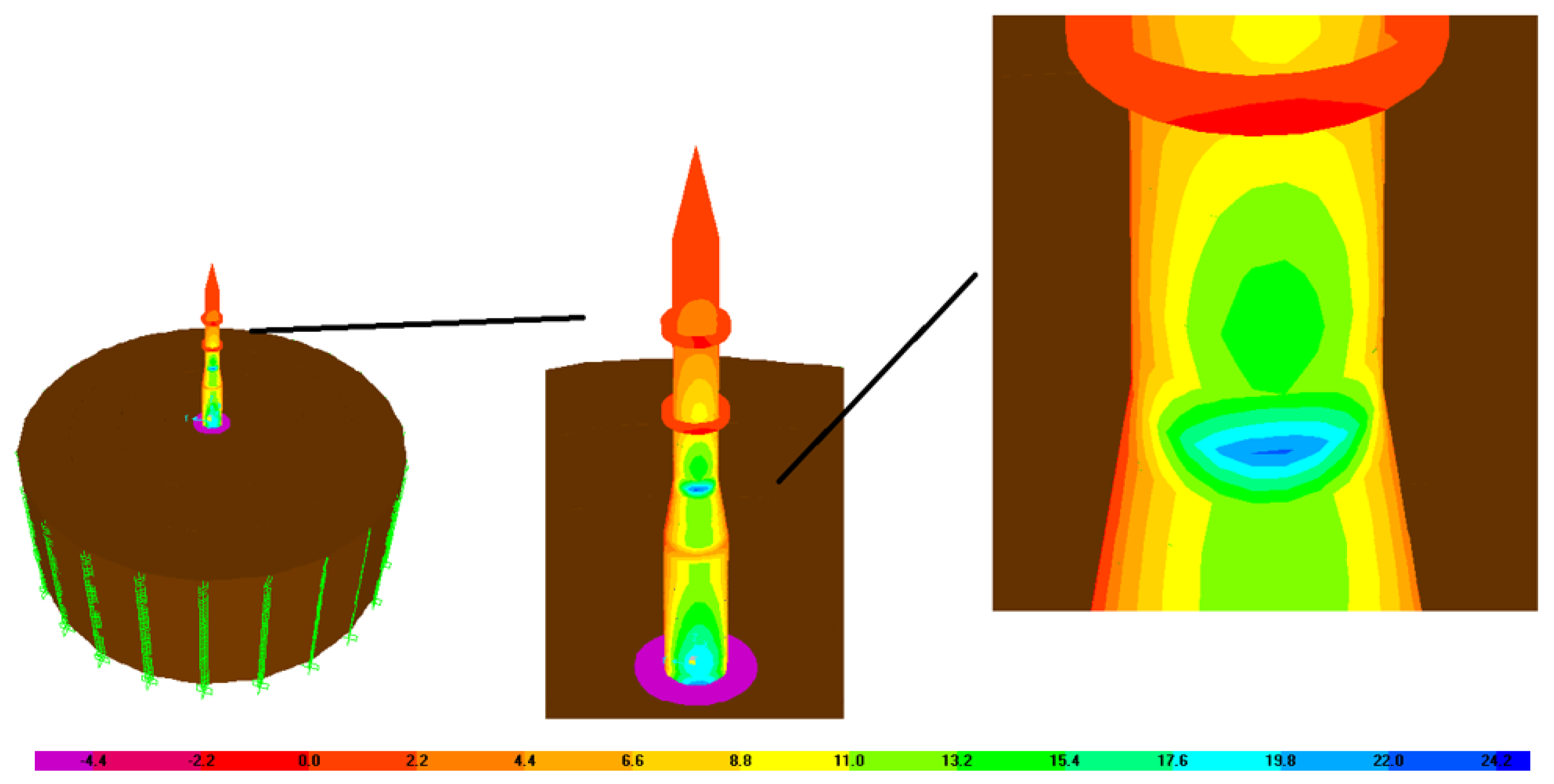
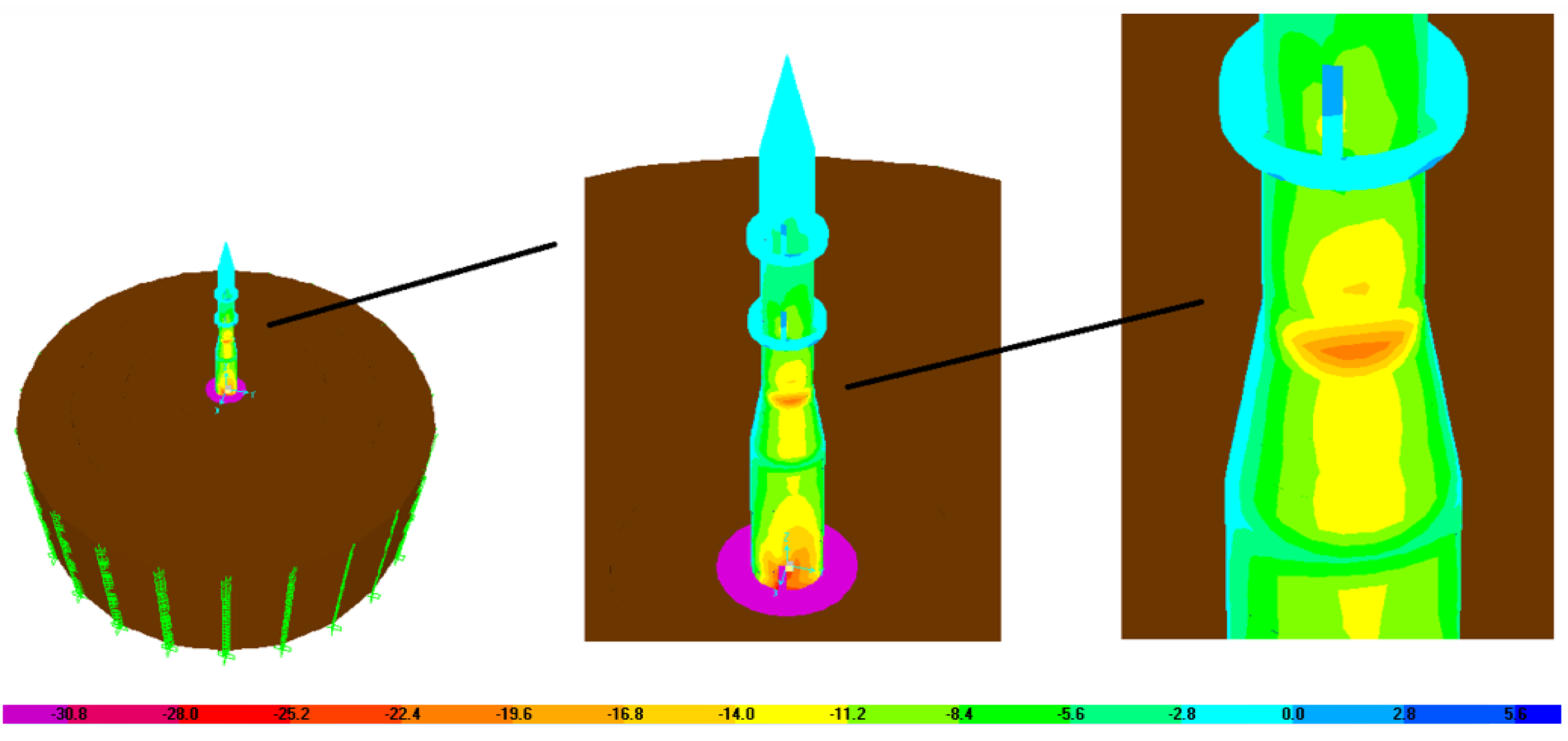

| Soil Type | E (kN/m2) | γ (kg/m3) | ν | vs (m/s) | vp (m/s) |
|---|---|---|---|---|---|
| S1 | 7,000,000 | 2000 | 0.3 | 1149.1 | 2149.89 |
| S2 | 500,000 | 1900 | 0.35 | 309.22 | 643.68 |
| S3 | 75,000 | 1800 | 0.4 | 120.82 | 295.95 |
| With SSI | |||
| Model 1 | Fixed | 0.214933 | - |
| S1 | - | 0.218611 | |
| S2 | - | 0.412332 | |
| S3 | - | 1.029321 | |
| Model 2 | Fixed | 0.21815 | - |
| S1 | - | 0.218475 | |
| S2 | - | 0.523131 | |
| S3 | - | 1.29032 | |
| Model 3 | Fixed | 0.235511 | - |
| S1 | - | 0.236422 | |
| S2 | - | 0.608591 | |
| S3 | - | 1.44093 |
| Model No | First Mode | Second Mode | Third Mode | Fourth Mode | Fifth Mode | Sixth Mode | Seventh Mode | Eighth Mode | Ninth Mode |
|---|---|---|---|---|---|---|---|---|---|
| Model 1 | 0.30 | 0.31 | 0.45 | 0.45 | 0.45 | 0.45 | 0.51 | 0.51 | 0.51 |
| Model 2 | 0.10 | 0.10 | 0.16 | 0.16 | 0.16 | 0.16 | 0.19 | 0.19 | 0.19 |
| Model 3 | 0.15 | 0.15 | 0.24 | 0.24 | 0.24 | 0.24 | 0.24 | 0.24 | 0.27 |
| Model No | Soil Type | Earthquake Data | Δi (cm) | hi (m) | Δi/hi | Damage Limitation State (0.5% or 0.005) [47] |
|---|---|---|---|---|---|---|
| Model 1 | Fixed | İzmit | 10.29 | 20 | 0.00514 | X |
| Van | 7.45 | 20 | 0.00372 | ✓ | ||
| S1 | İzmit | 15.39 | 20 | 0.00769 | X | |
| Van | 10.70 | 20 | 0.00535 | X | ||
| S2 | İzmit | 33.98 | 20 | 0.01699 | X | |
| Van | 26.71 | 20 | 0.01335 | X | ||
| S3 | İzmit | 70.45 | 20 | 0.03522 | X | |
| Van | 56.56 | 20 | 0.02828 | X | ||
| Model 2 | Fixed | İzmit | 11.46 | 25 | 0.00458 | ✓ |
| Van | 8.03 | 25 | 0.00321 | ✓ | ||
| S1 | İzmit | 16.33 | 25 | 0.00653 | X | |
| Van | 11.26 | 25 | 0.00450 | ✓ | ||
| S2 | İzmit | 33.67 | 25 | 0.01346 | X | |
| Van | 23.44 | 25 | 0.00937 | X | ||
| S3 | İzmit | 88.98 | 25 | 0.03559 | X | |
| Van | 49.49 | 25 | 0.01979 | X | ||
| Model 3 | Fixed | İzmit | 15.83 | 29 | 0.00545 | X |
| Van | 8.70 | 29 | 0.00300 | ✓ | ||
| S1 | İzmit | 31.38 | 29 | 0.01082 | X | |
| Van | 16.33 | 29 | 0.00563 | X | ||
| S2 | İzmit | 88.88 | 29 | 0.03064 | X | |
| Van | 72.40 | 29 | 0.02496 | X | ||
| S3 | İzmit | 83.44 | 29 | 0.02877 | X | |
| Van | 42.59 | 29 | 0.01468 | X |
Disclaimer/Publisher’s Note: The statements, opinions and data contained in all publications are solely those of the individual author(s) and contributor(s) and not of MDPI and/or the editor(s). MDPI and/or the editor(s) disclaim responsibility for any injury to people or property resulting from any ideas, methods, instructions or products referred to in the content. |
© 2024 by the author. Licensee MDPI, Basel, Switzerland. This article is an open access article distributed under the terms and conditions of the Creative Commons Attribution (CC BY) license (https://creativecommons.org/licenses/by/4.0/).
Share and Cite
Türkeli, E. Evaluation of a Simplified Direct SSI Method in the Dynamic Seismic Behavior of Traditional RC Minarets. Buildings 2024, 14, 1796. https://doi.org/10.3390/buildings14061796
Türkeli E. Evaluation of a Simplified Direct SSI Method in the Dynamic Seismic Behavior of Traditional RC Minarets. Buildings. 2024; 14(6):1796. https://doi.org/10.3390/buildings14061796
Chicago/Turabian StyleTürkeli, Erdem. 2024. "Evaluation of a Simplified Direct SSI Method in the Dynamic Seismic Behavior of Traditional RC Minarets" Buildings 14, no. 6: 1796. https://doi.org/10.3390/buildings14061796





